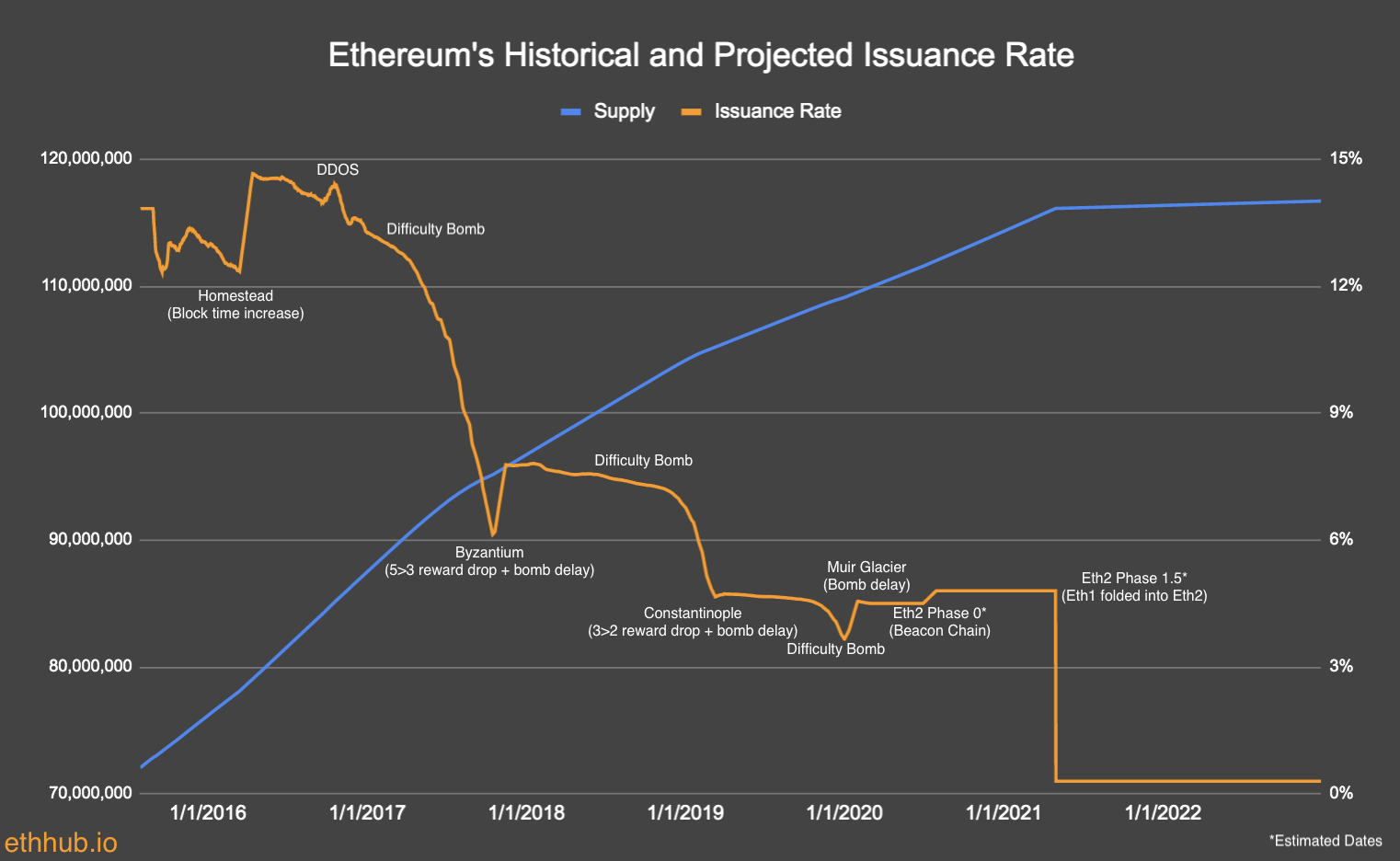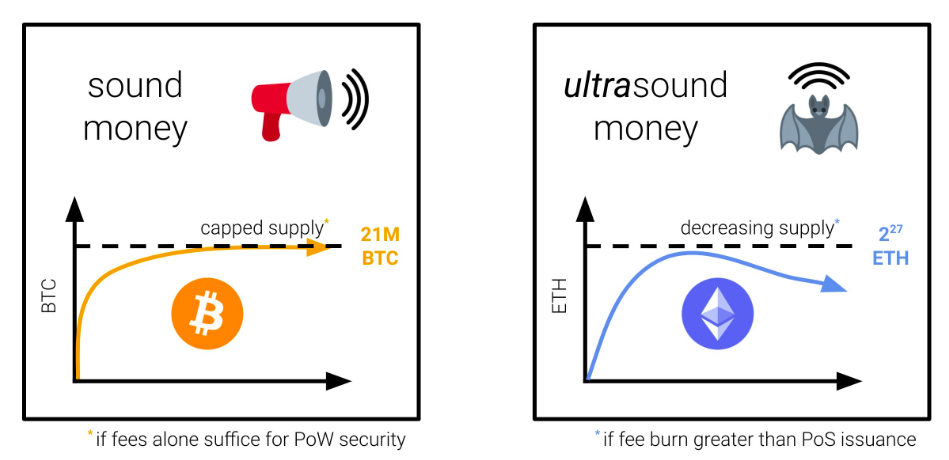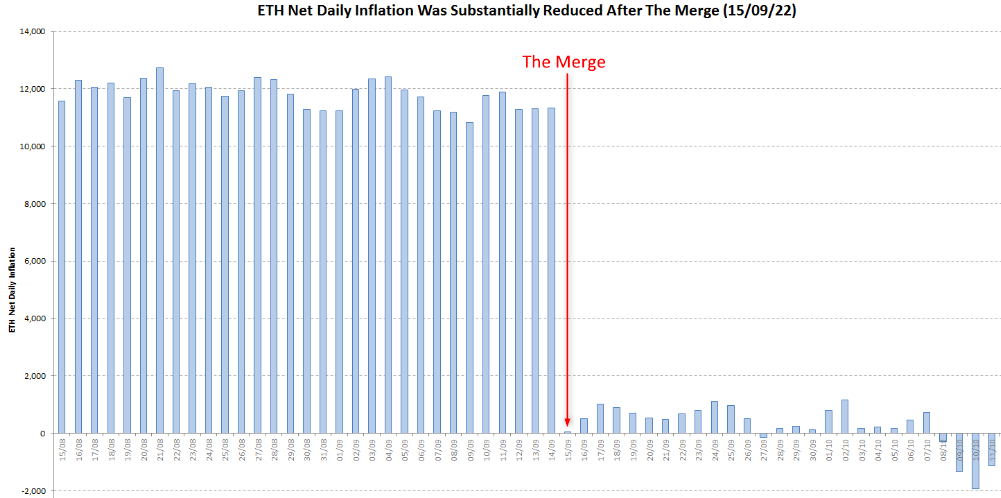ETH Merge
The Ethereum Merge, also known as ETH 2.0 is an upgrade that changed Ethereum’’s consensus algorithm from Proof of Work (PoW) to Proof of Stake (PoS)
Ethereum recently moved to a Proof of Stake consensus. The upgrade is known as ETH 2.0 or the Ethereum Merge.
The shift to PoS decreased the network’s energy output by as much as 99.9%, making it more eco-friendly. The upgrade also decreased the issuance of new tokens, making Ethereum less inflationary. But what does this mean for investors? And how does it affect the value of the second-largest cryptocurrency? In this article, we attempt to find out.
Table of contents
In brief
- Ethereum 2.0 is an upgrade of Ethereum’s consensus algorithm from PoW to PoS.
- The upgrade replaced miners with validators, decreased the network’s energy consumption, lowered inflationary token issuance, and offered staking opportunities for ETH holders.
- The price of Ethereum did not experience significant changes since the upgrade.
- Higher on-chain activity (bullish markets) will turn Ethereum into a deflationary asset.
Ethereum merge date
The Merge occurred on 15 September 2022. The Ethereum Proof-of-Stake date had been postponed multiple times prior due to technical issues.
What is the ETH Merge?
The Ethereum Merge, also known as ETH 2.0 is an upgrade that changed Ethereum’’s consensus algorithm from Proof of Work (PoW) to Proof of Stake (PoS).
Before delving into the details of ETH 2.0 it’s important to mention EIP-1559, an Ethereum upgrade that occurred prior to the Merge. The upgrade introduced fluidity to transaction fees and a burning mechanism for base fees. This, in turn, made ETH less inflationary.
This brings us to the ETH Merge date, which occurred a little more than a year later. Miners got replaced by validators, the energy consumption of the network dropped by 99.9%, and the issuance of new tokens dropped by 90% (4% to ~0.4% annually). This issuance reduction is equivalent to 3 Bitcoin halvings.
According to Ethhub, the shift happened in two phases:
- Eth2 Phase 0: Slight increase in token issuance due to the launch of Beacon Chain (the PoS chain).
- Eth2 Phase 1.5: Proof-of-Work rewards were eliminated due to the Eth1 PoW chain moving to the Eth2 chain. This is best described on the chart below (dates were estimates).

Based on the current PoS model, ETH transaction fees need to sustain 15-20 Gwei to offset token issuance. While some investors might still say that this is expensive for small transactions, remember that Layer 2 solutions are built to accommodate that. It’s therefore easy to see that:
EIP-1559 + ETH 2.0 = deflationary Ethereum supply (in non-bearish markets)
This, in turn, makes Ethereum a stronger rival against Bitcoin, which has a capped supply. While the deflationary nature of Ethereum does not guarantee its future price, it’s easy to see how it could lead to a bullish narrative. Pair this with recurring staking rewards and you have what Justin Drake calls “Ultrasound money”.

Ethereum 2 months since the Merge
We are now nearly two months post-ETH 2.0 and we can already measure results. Note that we find ourselves in bearish market conditions with decreased trading volumes and on-chain activity. Despite that, ETH is close to being deflationary.
As of today, daily token issuance has decreased by 98%, and several deflationary days start to appear.

As you may be able to tell, the 90% decrease in token issuance did indeed occur (±13k ETH to ±1.6k ETH daily). However, this was still insufficient to offset Proof-of-Stake issuance due to depressed on-chain activity. If the Ethereum network was able to experience the volumes of Q4, 2021 today, we would be burning ±13k every day. This gives but a small hint of what we could potentially see in a future bull market.
Ethereum forks (again)
Aside from the changes in price, we also saw a hard fork take place. A small group of investors, led by ex-miners, came together and forked the Ethereum network to create a new version of the PoW-based Ethereum. The split occurred on the Ethereum Merge date and the token, known as ETHW, did not manage to “take off”. Its price is currently worth less than 1% of the original Ethereum.
One might ask what the purpose of ETHW is when we already have Ethereum Classic (ETC). This is a valid concern and indicates that ETHW did not really aim to solve any existing problems in the Ethereum ecosystem. For reference, Ethereum Classic is the original chain of Ethereum prior to the DAO hack. It also works using a PoW consensus and is now widely seen as an Ethereum spinoff.
The result of all these forks is general confusion among early market participants when it comes to the differences between Ethereum Classic vs Ethereum vs ETHW. In short:
- Ethereum (ETH) is the original Ethereum, supported by Vitalik Buterin;
- Ethereum Classic (ETC) is an older version of Ethereum with PoW consensus;
- PoWEthereum (ETHW) is a new hard fork of Ethereum with PoW consensus.
Ethereum staking rewards
With the new PoS consensus model, investors are able to stake their ETH to generate interest. While the amount of staking rewards is fluid, depending on the number of staked ETH, projections indicate a return of anywhere between 4%-10%.
This form of passive income was initially reserved for those who can afford 32+ ETH, which is the needed amount to activate the validator software. Before the Merge, however, ETH 2.0 staking pools started to appear, both of centralized and decentralized nature. This lowered the barrier of entry.
In short, staking pools enable users to stake only a portion of the needed amount in order to receive a portion of the rewards. The service, or crypto exchange, becomes the validator and distributes rewards based on input.
Currently, 64% of all staked ETH is controlled by 5 entities, the biggest of which is Lido Finance.
Tracking the progress of Ethereum
There are several tools you can use to track the effects of the Ethereum Merge on the network:
- Ultrasound.money – This website shows a chart with the current ETH supply, as well as other useful metrics (issuance, supply growth, burn rate, supply change, etc.). It also enables you to make supply projections based on staked ETH, and average base gas price. It is the most useful tool from this list for everything related to the recent upgrade of Ethereum.
- Etherscan.io/blocks – Etherscan lists all Ethereum blocks with accompanying information, like static block rewards, transaction fees and how these are distributed. This makes it easy to see which rewards go to miners and which are burned (base fee).
- Etherchain.org/burn – Etherchain is similar to Etherscan. It shows all the Ethereum blocks, but it also shows additional information. This includes the total burned ETH, the current burn rate across different timeframes, and the current ETH emission rate (shows if ETH is inflationary or deflationary).
Ethereum merge price prediction
So when is Ethereum Merge going to reflect on the price of the token? According to several prominent investors, there is a high chance we see bullish sentiment in the coming months. They believe that Ethereum’s recent shift to PoS makes it a more attractive investment; one that will most likely grow in value.
Arthur Hayes, the co-founder of Bitmex, recently wrote an in-depth article on Ethereum’s future. While the article is more focused on the technical changes and future effects of ETH 2.0, he also gives an Ethereum Merge price prediction. According to him, we will eventually see ETH reach 5-figures.
But Arthur is not the only one who is bullish on ETH. Jordan Fish, the host of UpOnly and an early ETH investor, mentioned that there is a high chance that Ethereum’s marketcap surpasses that of Bitcoin in the near future.
Su Zhu of Three Arrows Capital believes that such a “flippening” is highly likely as well. In the same podcast linked above, he states that $15.000 per ETH is the lowest price we will see post-Merge. That is, once bullish sentiment returns.
Many guests of UpOnly share this sentiment as well. We highly suggest you look at the Ethereum-related podcast episodes of UpOnly better to familiarize yourself with the future potential of the Merge.
Note that the opinion expressed here do not constitute financial advice but an educated guess that can be used to assist your personal research.
Wrapping up
The upgrade of Ethereum to PoS makes the cryptocurrency a more rewarding investment with cash flow potential. This, in combination with its decreased carbon footprint and supply issuance will most likely increase its popularity among investors.
Since the Merge, the value of ETH has not seen massive growth, despite the expectations of many investors. The current market sentiment is bearish, and the price continues to decrease.
As many investors continue to sit on the sidelines, hype is slowly starting to build up. When bullish market conditions return, it is mathematically certain that Ethereum becomes a deflationary asset. This could increase the amount of staked ETH, lowering the circulating supply and increasing demand for the token. Therefore, if you wish to benefit from the current market conditions, buy ETH using Paybis.
FAQ
Does the price of ETH drop after the Merge?
Over the past 6 months, the price of Ethereum fluctuates between $1200-2000. This did not change with the Merge, as we are currently in a bear market.
Ethereum’s price has decreased by 10%, two months after its recent upgrade. Shortly before the Merge occurred, the price of Ethereum nearly doubled surpassing the lows of June, with many investors engaging in a “buy the rumor, sell the news” strategy.
Will ETH 2.0 have an impact on Shiba Inu?
No, while Shiba Inu (SHIB) is an ERC-20 token, ETH 2.0 is only relevant to Ethereum. Besides that, Shiba Inu already had a PoS consensus model, allowing investors to stake their tokens and claim rewards.
Will Ethereum 2.0 replace Ethereum?
No, Ethereum 2 (or 2.0) is simply the name of Ethereum’s latest upgrade. After the upgrade, a group of investors decided to fork the Ethereum chain, creating a new token, known as ETHW. This forked token still functions using the PoW consensus model but is not the original Ethereum. ETHW tokens were distributed to everyone holding ETH in their wallet at the time of the Merge.
What is the difference between Ethereum and Bitcoin?
Bitcoin is the first decentralized cryptocurrency and only has one use case, that of financial transactions. To understand what is Ethereum we need to look at all the additional applications that come with decentralized technology. The Ethereum network introduced smart contracts, which in turn set the foundation for many additional use cases and the introduction of Web3. Among these, we find P2E games, NFTs, and applications across multiple industries. You can purchase both Bitcoin and Ethereum on Paybis.
Disclaimer: Don’t invest unless you’re prepared to lose all the money you invest. This is a high‑risk investment and you should not expect to be protected if something goes wrong. Take 2 mins to learn more at: https://go.payb.is/FCA-Info


![12 Best Ethereum Miners for Maximum Profits [Updated After ‘The Merge’]](https://paybis.com/blog/wp-content/uploads/2019/10/Blog-1340x640-Best-Ethereum-Miners-1024x489.jpg)